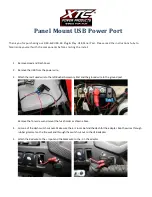
Electrical Components
Power Source
Power is supplied to the vehicle by two devices: The battery and the alternator. The
battery supplies electrical power during starting or during periods when the current
demand of the vehicle’s electrical system exceeds the output capacity of the alternator.
The alternator supplies electrical current when the engine is running. Not only does the
alternator supply the current needs of the vehicle, but it recharges the battery.
The Battery
In most modern vehicles, the battery is a lead/acid electrochemical device consisting of six
2 volt subsections (cells) connected in series, so that the unit is capable of producing
approximately 12 volts of electrical pressure. Each subsection consists of a series of
positive and negative plates held a short distance apart in a solution of sulfuric acid and
water.
The two types of plates are of dissimilar metals. This sets up a chemical reaction, and it is
this reaction which produces current flow from the battery when its positive and negative
terminals are connected to an electrical load. The power removed from the battery is
replaced by the alternator, restoring the battery to its original chemical state.
The Alternator
Some older vehicles use a generator instead of an alternator. The difference is that an
alternator supplies alternating current which is then changed to direct current for use on
the vehicle, while a generator produces direct current. Alternators tend to be more efficient
and that is why they are used.
Alternators and generators are devices that consist of coils of wires wound together
making big electromagnets. One group of coils spins within another set and the interaction
of the magnetic fields causes a current to flow. This current is then drawn off the coils and
fed into the vehicles electrical system.
Ground
Two types of grounds are used in automotive electric circuits. Direct ground components
are grounded to the frame through their mounting points. All other components use some
sort of ground wire which is attached to the frame or chassis of the vehicle. The electrical
current runs through the chassis of the vehicle and returns to the battery through the
ground (
–) cable. The battery ground cable is connected between the battery and the
frame or chassis of the vehicle.
NOTE:
It should be noted that a good percentage of electrical problems can be traced to
bad grounds.
Summary of Contents for TrailBlazer
Page 1: ......
Page 26: ...Fig 3 Typical body and undervehicle maintenance locations Refer to chart for descriptions ...
Page 29: ......
Page 30: ......
Page 31: ......
Page 175: ...Spring free length check Valve spring squareness check ...
Page 192: ...Front of piston mark ...
Page 361: ...5 3L Engine Except Saab Underhood Fuse Block 2003 2005 Early Production ...
Page 469: ...Removing the outer band from the CV boot Removing the inner band from the CV boot ...
Page 470: ...Removing the CV boot from the joint housing Clean the CV joint housing prior to removing boot ...
Page 471: ...Removing the CV joint housing assembly Removing the CV joint ...
Page 472: ...Inspecting the CV joint housing Removing the CV joint outer snap ring ...
Page 473: ...Checking the CV joint snap ring for wear CV joint snap ring typical ...
Page 474: ...Removing the CV joint assembly Removing the CV joint inner snap ring ...
Page 475: ...Installing the CV joint assembly typical ...
Page 553: ...9 Torque the lug nuts to specification 10 Lower the vehicle ...
Page 556: ...Toe in Frame Misalignment Frame misalignment ...
Page 588: ...Bleeding caliper ...
Page 624: ...Manifold gauge set components Refrigerant recovery recycling station ...
Page 676: ...A C Specifications ...
Page 677: ......
















































